In today’s article, we’re digging back into the newsletter archives for timeless information about online advertising that entrepreneurs at every level need to know.
The ads included as examples are from a few years back, but the message is more relevant today than ever before.
So… Let’s look at traffic, and specifically, how to increase your online traffic.
Now I’ll readily admit, I’ve spent thousands of dollars learning the secrets I’m about to tell you from some of the world’s top experts in online media buying – people like Charles Kirkland, Justin Brooke, Jon Loomer, and several other folks you would never have heard of…
This is all in addition to my own experiences when I first started buying media way back in 2008.
Buying media traffic is a critical part of The Predictable Profits Formula for growing and scaling your business. I recall internet marketing expert Rich Schefren saying something along the lines of:
“You don’t have a real business unless you can buy customers.”
You see, if you’re solely relying on word of mouth, referrals, and – if your brick-and-mortar, foot traffic – and don’t have a profitably strategy for acquiring customers, you don’t have a “real business.”
Without a profitable media buying strategy, you cannot scale your business to its full potential.
Radio, print, television, direct mail, and so forth are all excellent sources of media – however, the easiest, cheapest, and fastest way for most businesses to generate traffic starts on the internet.
Once you can make online advertising work for you, then you can scale to other media.
That’s why we’re talking about buying traffic online.
Understand that technologies and platforms change all the time, so I don’t want to get bogged down in the minutia of every media channel (Facebook, Google, Twitter, etc.) or the different types of online media (PPC, contextual, native, mobile) – rather, the purpose of this article is to pick up where most gurus leave off…
Providing you with evergreen principles proven to work across thousands of the largest media buying corporations – who have collectively spent billions of dollars acquiring traffic over the last decade plus.
These media principles are the very essence of a mega-successful media buying campaign.
They apply to just about every network, and separate the “average Joe marketer” from the strategic entrepreneur who uses media to bring in more cash and dominate their market.
Aside from the usual channels, take time to check out a few other alternative digital marketing networks that could boost your advertising campaigns (while costing you a lot less.)
I’ll say this again: these are foundational principles that – while often ignored – represent the BIGGEST impacts on the success (or failure) of your traffic generating strategies.
And heed my warning: this takes patience and persistence. There is no easy button and no magic pill to substitute the information we’re covering today.
In fact, anyone who tells you differently is trying to lure you into buying some fancy software or info-product – only adding to your distractions and sense of overwhelm. It’s like teasing you with the forbidden fruit in the Garden of Eden.
Sure, there’s no hiding the fact that media buying is (on the surface) a complex topic.
So, if you get a little lost or feel a little overwhelmed, I recognize that I’m balancing a fine line between basics and advanced tactics here. However, I’ll do my best to explain everything to you as thoroughly as possible so that, hopefully, I answer most (if not all) of your questions.
Understand this: buying traffic is a strategy. But more times than not, we’ll talk with entrepreneurs who decide to toss a few hundred bucks at Google or Facebook, buy a few keywords, and send these folks directly to their website’s home page – hoping to make it work.
“Hope” is their primary strategy.
And it’s the main reason they’re not making as much money as they should be…
With this strategy, they can’t accurately track their conversion rates… Or which keywords are making the most money (or losing the most money)… Or their ROI… Or have a strategy for recapturing lost traffic… Or take people to a narrowly targeted offer, focused on driving the highest conversion…
And the list of mistakes continues….
(If any of the above sounds like you, you’re not alone. The truth is: I know these mistakes because, up and until a few years ago, I made them too.)
You see, with increasing competition nipping at your heels, you cannot afford to waste time, money, and resources on an underperforming strategy when – with the right plan in place – you can immediately cut costs and increase profits.
Now, I think it’s important I address a common misconception…
Frequently, I hear rumblings about: “Adwords doesn’t work for us” or “Facebook advertising doesn’t work.”

Perhaps you think the same thing…
So it might surprise you that this is an article about buying media, and yet, I’ll confess that those claims are half-true.
The truth is:
You’ll seldom turn a profit without a strategic approach to media buying.
The average entrepreneur rarely makes online media buying work for them.
And I won’t dust the reality with unicorns and fairy dust either, because the little-known secret every professional media buyer will tell you is that the first online advertising campaign you run will seldom (if ever) create home run results for you.
In fact, the first time professional media buyers run a campaign, they often lose money – and it’s expected!
This why we test slowly…
Now, I’m a member of The Media Buyer’s Association . The gentlemen who runs it, Charles Kirkland, is one of the most respected media buying professionals in the world.
You’d think if anyone could “guarantee” a positive ROI the first time he ran a campaign, it would be Charles.
However, even with his extensive experience, each time he runs a new campaign, he’ll run a test… Often starting with less than $100.
But here’s the thing…
All Charles is doing is collecting data. He’s looking to find a winning ad, cut losing keywords, and find a highly converting offer – then he’s ready to slowly scale up.
I liken it to drilling for oil.
If you look at the way the big oil companies work, they’ll head over to a location that has a high probability of striking oil, and before they go all out and spend a ton of money drilling – they drill a test location.
If they don’t get the result they expected, they gather their data, move to another location, and drill again, all the while looking for clues for where the oil is. If and when they find oil, only then will they spend more money to extract as much as possible.
Media buying is the same way…
You see, the oil companies don’t go to a piece of land with the initial objective of striking it rich – rather, their initial goal is to gather data and determine whether or not there is oil to be mined in the first place.
To make money, you must determine what’s working and what’s not – so you can get rid of the losers and expand the winners.
Let’s say you find out you’re making $4.00 for every $1.00 spent on online advertising (I think you’ll agree that’s a good problem to have, right?). Once you have this information, you’ll want to spend as much money as possible.
But let’s not get too far ahead of ourselves…
Let’s start with how to approach this strategically, and take a very systematic approach to media buying focused on results.
As one of my mentors would say:
“There are reasons and results,
the only thing that matters are the results.”
^ I would commit that to memory, and repeat that saying daily.
The first objective in any media buying campaign is to collect data.
You need data on which of the following is working/not working:
- Advertisement
- Traffic source
- Keywords or interest group
- Offer
Any one of the above areas could make or break an online advertising campaign, so we set up our ads in a way that allows us to more easily determine what’s working and what’s not.
For a little bit of context, the average entrepreneur sets up their first media purchase by creating one campaign (or ad group), running one advertisement, and selecting a bunch of keywords or interest groups to display their advertisement to.
However, this presents a problem… By doing it this way:
- You can’t narrow down which specific segment of your target is converting
- You are not split testing your online advertisement for the best results
- You can’t narrowly and specifically target the landing page to speak directly to your target
In other words, you’re leaving the door open for incomplete data and sub-optimized performance.
Again, no one said media buying was going to be easy (neither is drilling for oil). However, when you follow this plan – and begin to strike oil for yourself – you’ll see exactly how quickly you can double, triple, quadruple, and more the amount of sales and leads in your business.
Heck, the first time I figured this out, I spent around $5,000 testing different keywords, landing pages, and offers. I was convinced it wasn’t going to work… However (and fortunately), I didn’t give up.
Then all of a sudden, I discovered one of my keywords made money… Then another… Then another. I turned the $5,000 of testing into approximately $250,000 in revenue 12 months – and for every dollar I spent in media, I was getting another $1.00 back in profit – a 100% return on my money.
The campaign was working so well that I received an offer to buy all my intellectual property (keywords, landing page, etc.) – and sold it for a nice gain.
So, let’s start with the strategic structure of your media buying campaign.
STEP 1: Set up a new ad group (aka “ad campaign”) for each person or keyword you’re targeting. For example, you can have an advertising group for “male entrepreneurs who are 55+” and another one for “female entrepreneurs who are 55+.”
Start with a few campaigns and build from there…
STEP 2: Split test 2 different advertisements. Each online advertisement is speaking directly to a particular campaign target you’re testing.
For example, here’s an add you might run to a male, 55 and older:
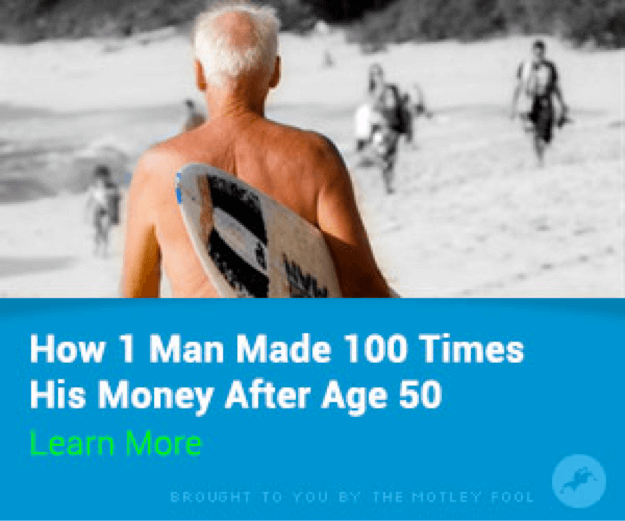
…Versus this advertisement that might work best for people between the ages of 35 and 45:
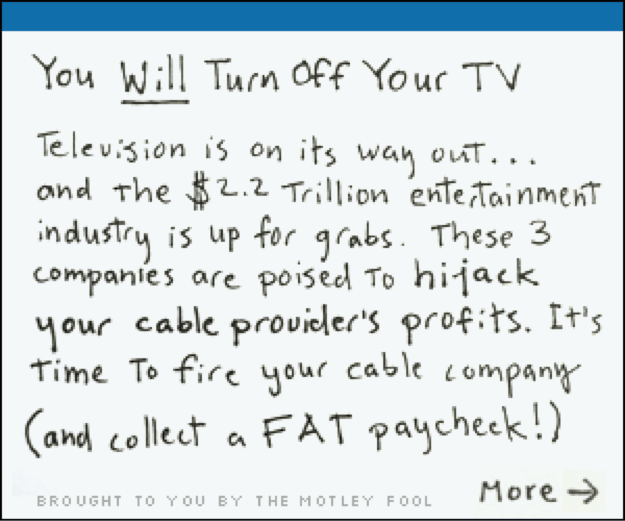
(Both of these ads come from The Motley Fool, a very strategic, 9-figure gorilla in the online world)T
STEP 3: Drive each online advertisement to a specific landing page narrowly targeted to your specific audience.
Do NOT take people to your home page. Use a specific landing page focused on solving a specific need for each target market.
To piggyback on the Motley Fool example:
Here’s a simple, high-converting landing page suitable for someone nearing retirement:
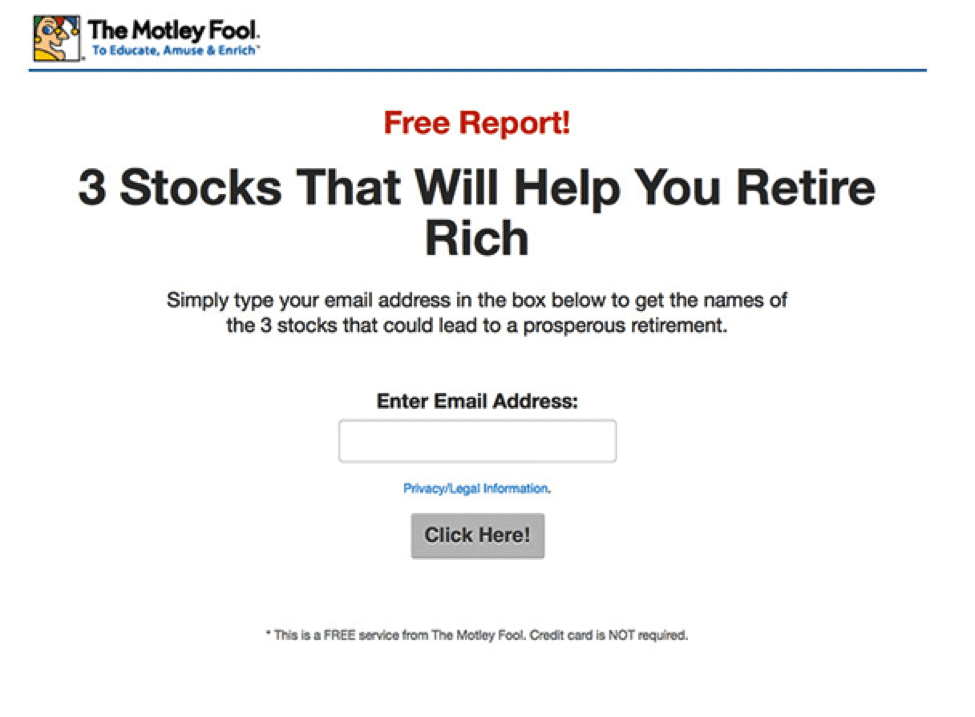
Here’s a landing page for someone who is retired:
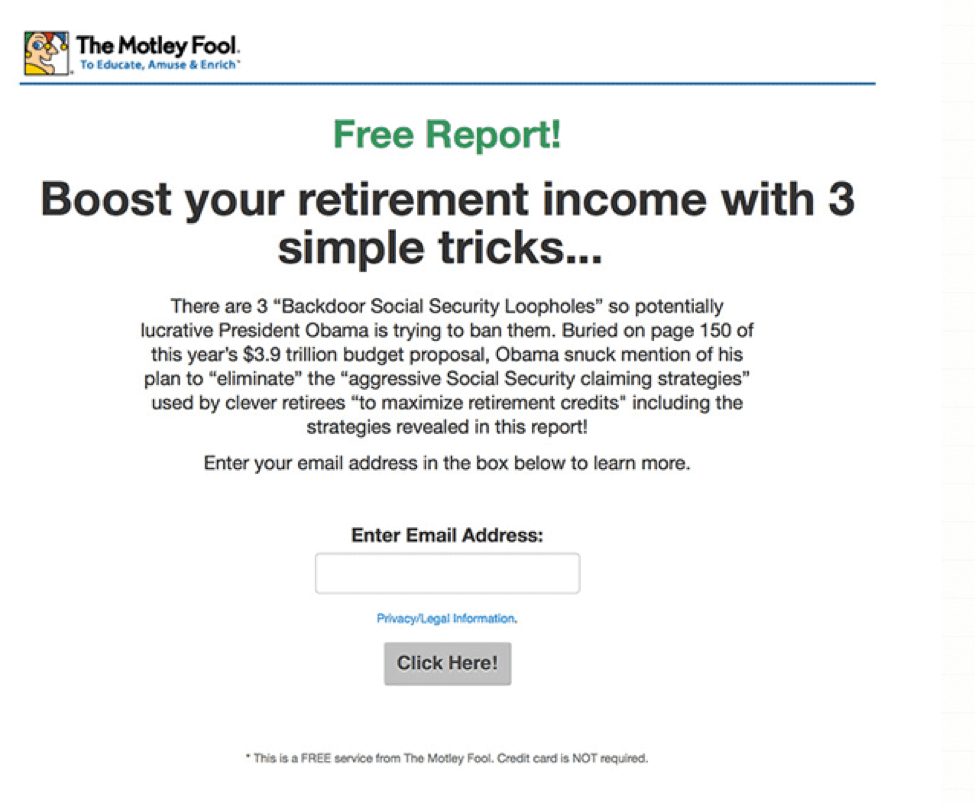
And one appropriate for the younger crowd, 35-45 years old:
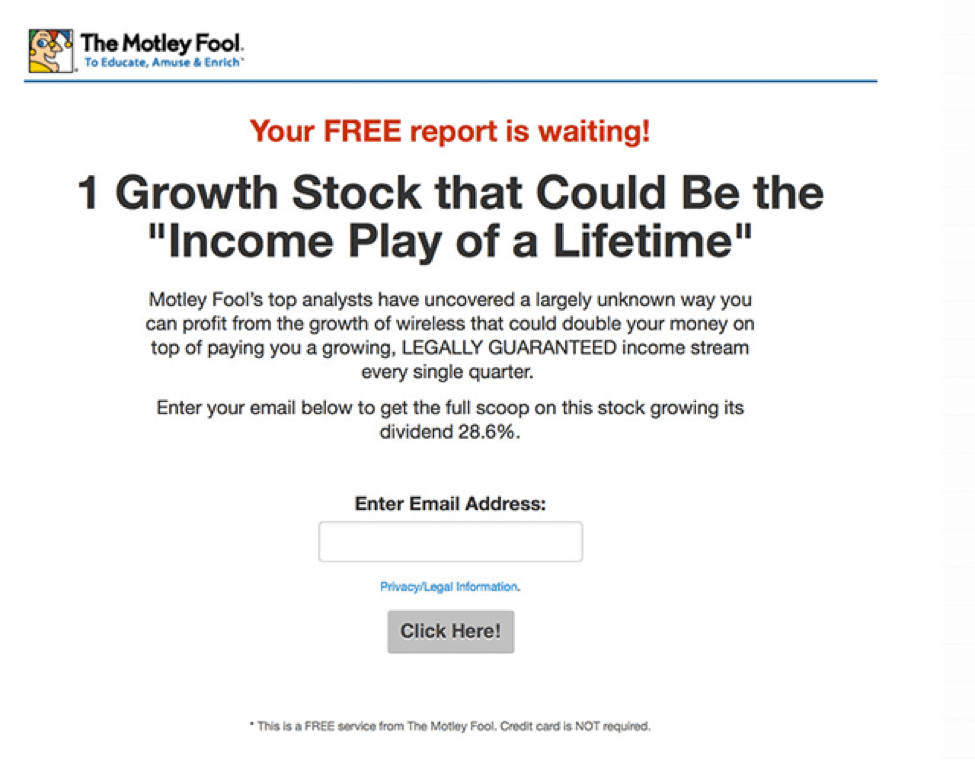
TIP: GO TO SWIPED.CO FOR OTHER LANDING PAGE EXAMPLES
Now, here’s an illustration of what your online advertisement structure might look like:
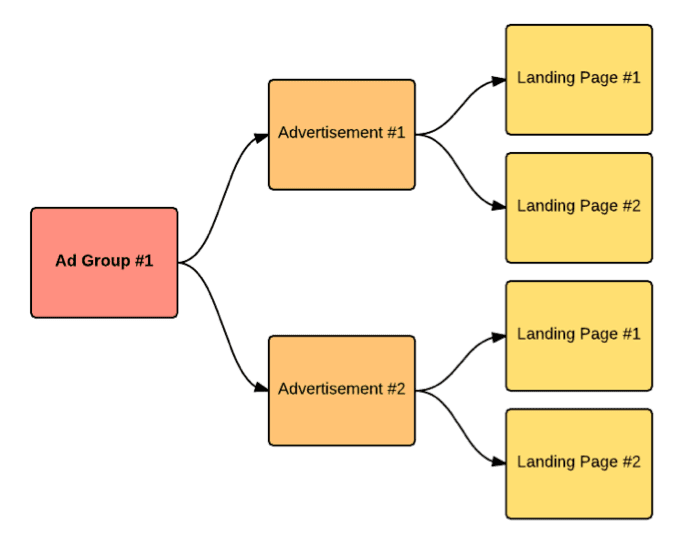
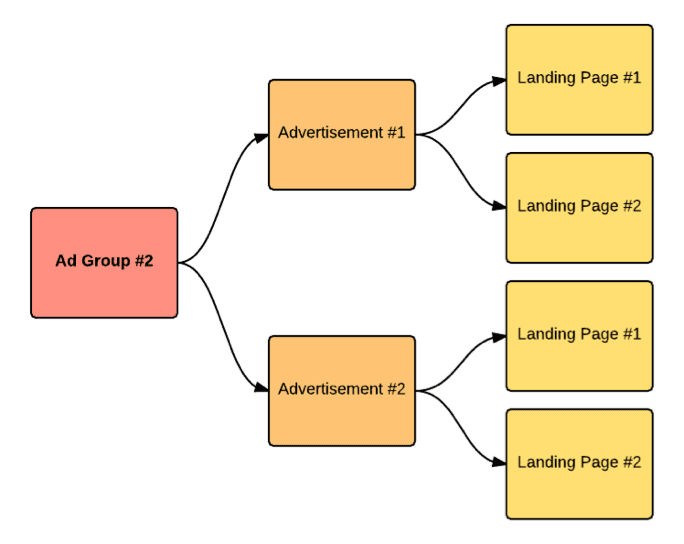
This structure – along with ensuring you have the proper conversion pixels, tracking, and analytics in place on your website – allows you to collect data, revealing what market segment is most profitable, which online advertisement works better, and which landing page converts the best.
TIP: Most ad networks will provide you with their own conversion pixels (and instructions to install them). Google Analytics provides world-class analytics (and it’s FREE). Improvely.com is a powerful advertising tracking tool worth considering, and if you use Facebook for traffic (which you should test) – AdEspresso.com is an invaluable tool for creating, testing, and tracking multiple campaigns.
You can also break out the ad groups by desktop traffic and mobile traffic to see which one works best.
The more you break things down – and the more you narrowly focus in on the variables – you’ll be able to optimize your campaigns for maximum profit…
Here’s an example of the potential impact this can have on your business:
I’m working with a coaching client who told me his online advertising budget was $100 a day on Facebook.
(A budget is usually a telltale sign that they don’t accurately track their ROI – after all, if you knew you were making $4.00 for every $1.00 spent, why wouldn’t you want to spend as much as possible?)
My client averaged $26.00 for every lead he acquired. Because he had no ad structure (like the one we just discussed), I knew we could collect better data to bring these costs down. We showed him how to structure his ads, cut out the losing keywords/targets, and got his lead costs down to as low as $3.24 per lead!
He went getting 3-4 leads per day to over 30 leads a day with the same budget!
That’s a 1,000% increase in leads!
Think about it: how much more money could you make with 1,000% more leads than you’re getting now?
This is an example of the low-hanging fruit that’s available to you.
What was my secret?
I consulted media guru Charles Kirkland for his advice, and he recommended we create two separate ad groups: one for married individuals and one for single individuals. In my mind, this was a bizarre test, given the service we were selling had (presumably) nothing to do with someone’s marital status.
However, we surprisingly discovered married folks had significantly more interest in our client’s services than single folks.
Similarly, we also tested mobile traffic vs. desktop traffic (and found MUCH cheaper leads via mobile).
The thing to understand here is that we would have never come to that conclusion without setting up our ad campaign correctly, using the structure I just shared above…
This is another reason it pays to spend the time and define your ideal client – the more detail and care you take toward defining your ideal client, the more targeted your offer, the higher the conversation rate, and the lower your customer acquisition costs will be.
Claude Hopkins, one of marketing’s greatest minds of our time, said:
“Platitudes and generalities roll off the human understanding like water off of a duck’s back. They make no impression whatsoever.”
This is why you want to target a specific market, show them an ad that’s specific and relevant to their needs/wants, and take them to a landing page that’s also specific to their needs/ads.
Don’t try to be all things to everyone! That’s one of the biggest mistakes in media buying – and marketing in general.
Does this mean that it will take you longer to set up your campaigns?
Yup.
Is it worth it?
Yup.
BIG TIME.
This is how you go an inch wide and a mile deep to dominate your space.
So, that’s how you set up your campaign up…
But wait a minute!
Even if you set it up correctly, we still need to reverse engineer your marketing funnel to set a realistic expectation of what’s possible…
In fact, this will tell you if you even have a real chance of making money – before you spend money on online advertising.
For this example, let’s walk through a basic webinar funnel consisting of:
STEP 1: Webinar Registration Page
STEP 2: Webinar/Sales
Let’s use the following assumptions:
- PRODUCT PRICE: $497
- PAID CLICKS TO THE WEBINAR REGISTRATION PAGE: 1,000
- AVERAGE COST PER CLICK: $2.00
1,000 clicks x $2.00 per click = $2,000 in advertising expense.
So, let’s see how this plays out…
Our standard webinar registration page converts at 38% (this means that for every 1000 visitors to the page, 380 people register for the webinar).
Of the 380 people who register for the webinar, 3% of these people will purchase (of course, if you script your webinar correctly, you could get much higher conversion).
That means, at a 3% conversion rate, we’ll make a total revenue of $5,666.

You spent $2,000 on advertising so… You net a profit of $3,666! Congratulations – that’s awesome!
Let’s say you know, from past experience, that you can convert people on the webinar… However, because this is a new traffic source, the biggest unknown is the registration page conversion rate.
What happens if, instead of 38% (which is what you did in the past), it drops. What’s the lowest webinar registration rate you can feasibly be willing to accept to (at a minimum) break even.

Now, you can see that even at 20%, you’re doing pretty good – as long as you convert at 2% (which you know is no problem for you, as long as you have a qualified audience).
Awesome – this campaign is working so well, you’d like to open up more media channels.
Your friend tells you to advertise on Google Search, but when you do a little research using the Google Keyword Tool, you realize the suggested bid is $6.86 for your main keyword.

So, using your original assumptions of $6.86 per lead, in order to make this work for you, you’d need to convert people at 4%.

That’s just a risk you’re not willing to take at this moment, so you continue to find other traffic sources (or keywords) for less money per click.
Now, of course, we’re basing our numbers on the conversion rates of the campaign… However, you can also run these numbers based on the lifetime value of a customer. For example, Jay Abraham tells a story about Icy Hot:
The product sold for $3.00 and cost $.48 to manufacture, package, and ship out a jar. Because Jay knew that 35% of everyone who tried Icy Hot repurchased at least 6 times a year with an average order of $10.00 – he was willing to spend up to $3.45 to sell someone a $3.00 jar on the front end… Knowing he’s make money in the back end.
So, for a one-time loss of about $930,000, Jay eventually added $21 million a year to the business. (Source)
Now that’s the type of money is worth getting out of bed for!
